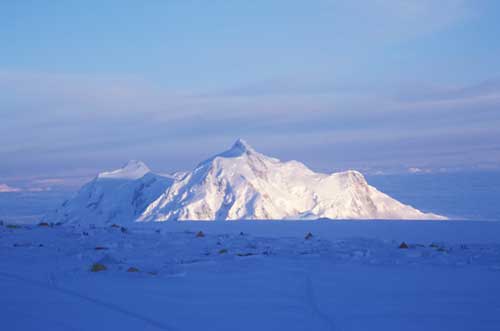 by Ned Rozell August 23, 2003
 Ned Rozell photo.
Orth's book, a government document last updated in 1971, is full of revelations, including the fact that Alaska "is a corruption." Orth explained: "The name and its application to the State and peninsula was well established in the late 1880s when W.H. Dall wrote: 'This name, now applied to the whole of our new territory, is a corruption, very far removed from the original word . . . called by the natives Al-ak-shak or Al-ay-ek-sa . . . From Alayeksa the name became . . . Alaksa, Alashka, Aliaska, and finally Alaska.'" William Dall explored and mapped much of Alaska during the late 1800s, and he is one of the many eclectic sources for Alaska place names, most of which were bestowed by Natives, seafaring Russians, British, Spaniards, French and Italians, and the ubiquitous gold miners who followed them. By my count,Dall is the person whose name remains on the most features in Alaska: two mountains, a bay, a glacier, a lake, a ridge, a river, and a point of land jutting into the Bering Sea, which is one of four places named for explorer Vitus Bering. Bering was the first non-Native to spot Alaska, when in 1728 he named St. Lawrence Island. Politics played a role in some of the biggest names in Alaska. Fairbanks began as "Barnette's Cache," which was accurate and descriptive, then took its current name in 1902 "to honor Charles Warren Fairbanks," a senator from Indiana. The village of Dillingham was named for a Vermont senator who had toured the state in 1903, and the Koyukuk River village of Hughes took its name after a governor of New York. In 1896, a prospector named William A. Dickey kindled one of the state's enduring debates when he named the tallest mountain in North America "after William McKinley of Ohio, who had been nominated for the presidency, and that fact was the first news we received on our way out of that wonderful wilderness." In 1943, members of the U.S. Army Alaskan Test Expedition named a prominent feature on the mountain Denali Pass "so that the old Indian name for McKinley would forever be preserved on a prominent feature near the top of the peak." Mount Hunter, one of Mt. McKinley's lovely neighbors, owes its name to a 1906 mistake by R.W. Porter of the U.S. Geological Survey. Porter labeled the 14,573-foot peak "Mt. Hunter" when the real Mt. Hunter stood only about 9 miles southeast. A New Yorker who visited the area in 1903 had named the smaller mountain in honor of his aunt, Anna Hunter, who had paid for his trip to Alaska. Many Native names survived the gauntlet of white exploration; one of them might be the longest name in Orth's dictionary-the Nunathloogagamiutbingoi Dunes, sand dunes that extend for three miles along the southeast coast of Nunivak Island. Some of my favorite Alaska
names speak for themselves: Lost Temper Creek, named by a geologist
in 1950 "because of a camp incident;" Mishap Creek,
named by a man who stripped naked to cross a creek, then watched
his clothes disappear downstream as he attempted to throw them
across; Odor Creek, which smelled of petroleum; and the Ribdon
River, named by USGS scientists in 1951 because "one of
the geologists named Don had a rib injury."
Source of story & photograph:
|